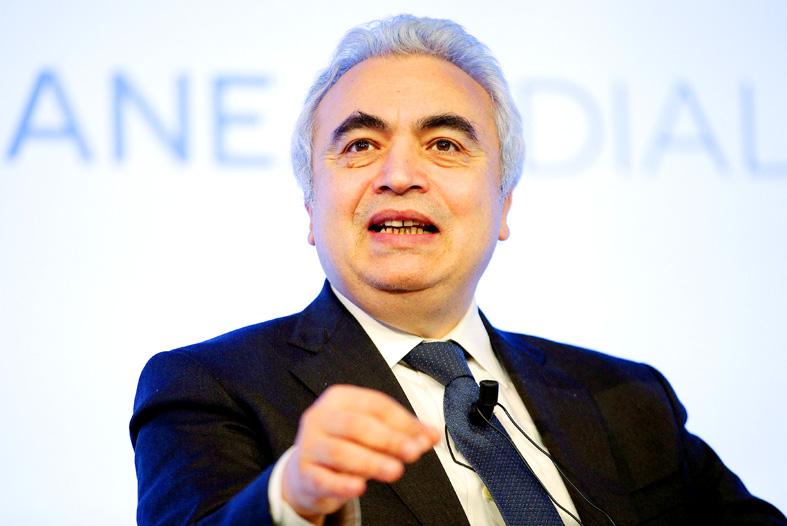The International Energy Agency (IAE) said the world could lessen an oil shortage caused by Russia’s invasion of Ukraine by restricting how people use their vehicles and accelerating the transformation of cities toward alternative means of transportation.
“We are experiencing a major crisis,” IEA executive director Fatih Birol told a news conference on Friday. “Oil markets are in an emergency situation. And not only that — it may even get worse than today in the next few months.”
The IAE said advanced economies could reduce their daily oil demand by 2.7 million barrels within four months by following a 10-step plan that would significantly ease looming supply strains by almost offsetting the loss of 3 million barrels per day from Russian production that the agency anticipates for April.

Photo: Reuters
“These efforts would reduce the price pain being felt by consumers around the world, lessen the economic damage, shrink Russia’s hydrocarbon revenues and help move oil demand to a more sustainable pathway,” the Paris-based agency said in a report.
Russian President Vladimir Putin’s invasion of Ukraine has upended global commodity markets, sending prices soaring and prompting an urgent search for alternative sources of energy.
While most states — excluding the US and UK — have not banned Russian oil imports, and none of its major customers are sanctioning natural gas supplies, there could still be disruptions as buyers voluntarily shun trade with Moscow.
The IEA’s plan to curtail oil demand includes lower speed limits for vehicles, urging people to work from home, placing occasional limits on vehicle access to city centers, making public transportation cheaper, encouraging carpooling, and greater use of high-speed rail and virtual meetings instead of air travel.
Earlier this month, the agency said the EU could slash imports of Russian gas by one-third within a year by increasing purchases from elsewhere, ramping up renewables and boosting energy efficiency.
In related news, the world’s three biggest oil field service providers are halting new projects in Russia in response to Moscow’s invasion, announcing their decisions separately within 24 hours of each other.
Baker Hughes Co on Saturday became the latest, saying in a statement that it is suspending new investment in Russia, but continuing with existing work there.
That followed a similar statement by Schlumberger NV late on Friday, when the world’s biggest oil field contractor immediately cut any new investment in one of the biggest oil-producing nations while leaving existing work there intact.
“The crisis in Ukraine is of grave concern, and we strongly support a diplomatic solution. We condemn violence and our hearts go out to the people and families of those impacted,” Baker Hughes chief executive officer Lorenzo Simonelli said in the statement.
Halliburton Co, the world’s top provider of fracking services, is the only oil field contractor to halt current and future work in Russia.
The company followed some of the largest oil explorers, including BP PLC and Shell PLC, in announcing plans to abandon Russia.

CHIP RACE: Three years of overbroad export controls drove foreign competitors to pursue their own AI chips, and ‘cost US taxpayers billions of dollars,’ Nvidia said China has figured out the US strategy for allowing it to buy Nvidia Corp’s H200s and is rejecting the artificial intelligence (AI) chip in favor of domestically developed semiconductors, White House AI adviser David Sacks said, citing news reports. US President Donald Trump on Monday said that he would allow shipments of Nvidia’s H200 chips to China, part of an administration effort backed by Sacks to challenge Chinese tech champions such as Huawei Technologies Co (華為) by bringing US competition to their home market. On Friday, Sacks signaled that he was uncertain about whether that approach would work. “They’re rejecting our chips,” Sacks

It is challenging to build infrastructure in much of Europe. Constrained budgets and polarized politics tend to undermine long-term projects, forcing officials to react to emergencies rather than plan for the future. Not in Austria. Today, the country is to officially open its Koralmbahn tunnel, the 5.9 billion euro (US$6.9 billion) centerpiece of a groundbreaking new railway that will eventually run from Poland’s Baltic coast to the Adriatic Sea, transforming travel within Austria and positioning the Alpine nation at the forefront of logistics in Europe. “It is Austria’s biggest socio-economic experiment in over a century,” said Eric Kirschner, an economist at Graz-based Joanneum

BUBBLE? Only a handful of companies are seeing rapid revenue growth and higher valuations, and it is not enough to call the AI trend a transformation, an analyst said Artificial intelligence (AI) is entering a more challenging phase next year as companies move beyond experimentation and begin demanding clear financial returns from a technology that has delivered big gains to only a small group of early adopters, PricewaterhouseCoopers (PwC) Taiwan said yesterday. Most organizations have been able to justify AI investments through cost recovery or modest efficiency gains, but few have achieved meaningful revenue growth or long-term competitive advantage, the consultancy said in its 2026 AI Business Predictions report. This growing performance gap is forcing executives to reconsider how AI is deployed across their organizations, it said. “Many companies

France is developing domestic production of electric vehicle (EV) batteries with an eye on industrial independence, but Asian experts are proving key in launching operations. In the Verkor factory outside the northern city of Dunkirk, which was inaugurated on Thursday, foreign specialists, notably from South Korea and Malaysia, are training the local staff. Verkor is the third battery gigafactory to open in northern France in a region that has become known as “Battery Valley.” At the Automotive Energy Supply Corp (AESC) factory near the city of Douai, where production has been under way for several months, Chinese engineers and technicians supervise French recruits. “They